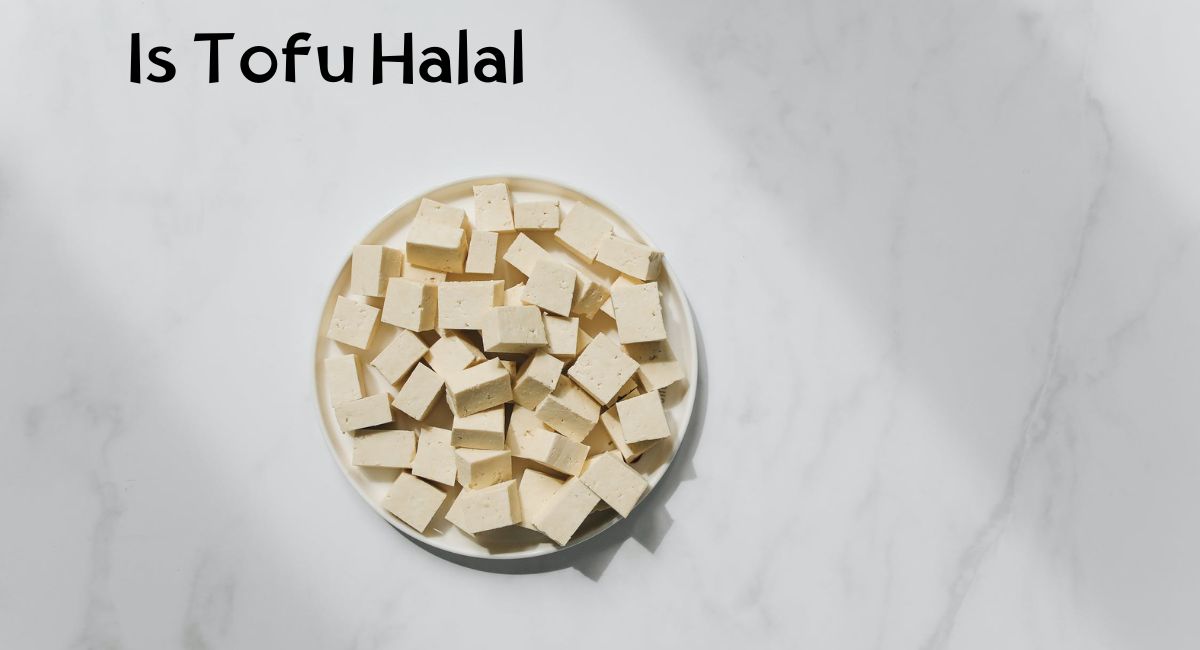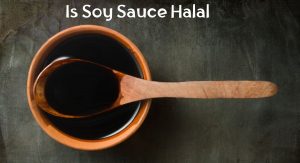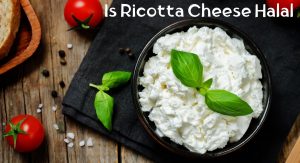Yes, tofu is considered halal for consumption by Muslims. Tofu is made from soybeans through a process that involves soaking, grinding, and curdling the soy milk, usually with the help of a coagulant like calcium sulfate or magnesium chloride. The resulting curds are then pressed and formed into tofu. Since soybeans are plant-based and the coagulants used are mineral-derived, tofu does not involve any prohibited or questionable ingredients according to Islamic dietary guidelines.
Tofu is an ancient food that has captivated the hearts and minds of many across all cultures and religious backgrounds. It is deliciously versatile, full of protein, low in fat, and a great alternative to meat for those following vegetarian or vegan diets. But one question remains—is tofu halal?
The answer is complicated as it largely depends on how it was prepared.
In this article, we’ll explore exactly what tofu is, the various types available, how it’s made from bean curd, why certain Muslims might avoid consuming tofu altogether – including if stinky tofu would be considered halal – plus a look at its nutritional properties that make it so beneficial in our diets.
Finally we’ll wrap up with some tips on how to kick-start your cooking journey with delicious recipes featuring this incredible ingredient! Let’s dive right into this fascinating discussion together!
What is Tofu?
Tofu is a soy-based food that originated in China over 2000 years ago. It is made from curdling soy milk with a coagulant, then pressing the curds into blocks. Also known as bean curd, tofu is a versatile food widely used in East Asian and Southeast Asian cuisines.
The first written record of tofu dates back to the Han dynasty (206 BC– 220 AD). From China, tofu spread to other countries in East Asia such as Japan, Korea, Vietnam, and Thailand where it became an important part of their cuisines.
It was introduced to the Western world in the mid-20th century and has since gained popularity as a meat substitute due to its high protein content and versatility in cooking. Today, tofu is widely available in supermarkets and health food stores across North America and Europe.
In culinary terms, tofu can be prepared in various ways, including raw, stewed, stir-fried, or deep-fried. It is used in a variety of dishes and cuisines, ranging from soups and stir-fries to desserts and smoothies. Tofu is highly versatile and can absorb the flavors of other ingredients, making it a popular ingredient in both Asian and Western vegetarian and vegan cooking.
Types of Tofu

Tofu is a versatile, plant-based ingredient that can be made from different types of ingredients. While tofu is traditionally made with soybeans, it can also be made with other plant-based alternatives such as wheat gluten, almonds, cashews and more.
Tofu can also be processed in different ways to give it unique textures and flavors. Here are some of the types of tofu commonly available:
- Silken Tofu: Silken tofu has a delicate and creamy texture. It is often used in dishes like soups, smoothies, and desserts.
- Firm Tofu: Firm tofu holds its shape well during cooking and is versatile in various recipes. It can be sliced, diced, or crumbled. Firm tofu is commonly used as a meat substitute in dishes like stir-fries, curries, and tofu scramble.
- Extra-Firm Tofu: Extra-firm tofu has a denser texture and a lower water content compared to firm tofu. It holds its shape even better, making it suitable for grilling, pan-frying, or baking. Extra-firm tofu is often used in dishes that require a firmer texture, such as stir-fries, kebabs, or sandwiches.
- Soft Tofu: Soft tofu has a higher moisture content and a softer texture. It is commonly used in dishes that require a creamy texture, such as soups, stews, or Korean soft tofu stew (sundubu jjigae).
- Tofu Skins (Yuba): Tofu skins, also known as yuba, are thin sheets of tofu that form on the surface of heated soy milk. They have a chewy and slightly gelatinous texture. Tofu skins can be used in rolls, wraps, or soups.
- Fermented Tofu: Fermented tofu has a distinct flavor and aroma similar to cheese. It is often used as a condiment or flavoring agent in dishes like congee, sauces, or stir-fries.
- Fried Tofu: Fried tofu is made by deep-frying tofu cubes or slices until they become crispy on the outside while maintaining a soft interior. It is commonly used in stir-fries, soups, or served as a side dish.
- Seasoned Tofu: Seasoned tofu comes pre-flavored or marinated with various spices and seasonings. It offers convenience and can be used directly in salads, wraps, sandwiches, or as a snack.
- Tofu Puffs: Tofu puffs are small, spongy cubes made from fried tofu. They have a porous texture that absorbs sauces well, making them suitable for soups, curries, or stir-fries.
What is Tofu Made of?
Tofu is a traditional Chinese food made from soybeans that are mashed into a pulp and mixed with water. It is then coagulated, pressed, and cut into blocks or slices.
The main ingredients used to make tofu include
- Soybeans: Tofu is primarily made from soybeans. The soybeans are soaked, ground, and mixed with water to make soy milk.
- Coagulant: A coagulant is added to the soy milk to promote coagulation and separation of curds and whey. Common coagulants used in tofu production include nigari (magnesium chloride), gypsum (calcium sulfate), and calcium chloride.
The exact proportions of soybeans, water, and coagulant may vary depending on the desired texture and firmness of the tofu. Additionally, some commercial tofu products may contain additives or flavorings for specific varieties or preparations.
How is Tofu Made?

Tofu is a nutritious food made from soybeans, and the process of making tofu involves several steps. Here is a comprehensive explanation of how tofu is made:
- Soybeans: Tofu is primarily made from soybeans, which are soaked in water to rehydrate them and remove any impurities or debris.
- Grinding: The soaked soybeans are ground into a fine paste. Traditionally, this was done manually using stone mills, but modern production methods involve the use of mechanical grinders or blenders.
- Extraction: The ground soybean paste is mixed with water to create soy milk. The mixture is then heated and simmered to extract the flavors and nutrients from the soybeans.
- Coagulation: To coagulate the soy milk and separate it into curds and whey, a coagulant is added. The most commonly used coagulants are nigari (magnesium chloride) or gypsum (calcium sulfate). These coagulants cause the proteins in the soy milk to come together and form curds.
- Curd formation: The coagulated soy milk is left undisturbed to allow the curds to form. This process takes around 15-30 minutes, during which the curds become more solidified.
- Pressing: Once the curds have formed, they are transferred to a tofu mold lined with cheesecloth or muslin. The curds are then pressed to remove excess liquid and shape them into blocks. This can be done using a tofu press or by placing weights on top of the curds.
- Cooling and packaging: After pressing, the tofu is cooled to room temperature, and then it can be packaged and refrigerated for storage or further processing.
It’s important to note that there are variations in the process of making tofu depending on the desired texture and firmness. For example, silken tofu is made using a slightly different method that involves less pressing, resulting in a softer and more delicate texture.
Is Tofu and Paneer Same?
Tofu and paneer are both widely used ingredients in Asian cuisines. However, they are distinctly different products that have a range of unique characteristics.
Tofu is made from soybeans which are soaked overnight, blended into a slurry, and then formed into blocks using coagulants like calcium sulfate or magnesium chloride. This process makes tofu a vegan alternative to meat or dairy-based products like cheese and yogurt. It also means that all types of tofu— even the stinky variety—are Halal for Muslims as they do not contain any animal-derived ingredients nor involve alcohol in the production process.
Paneer on the other hand is made by curdling cow’s milk with an acid such as lemon juice or vinegar before pressing it into cakes. As it involves milk, some Muslims may choose to avoid paneer if their religious leaders consider its consumption haram (forbidden) due to uncertainty about how the cows were treated during milking and processing.
In terms of nutritional value, tofu is higher in protein than paneer while containing fewer calories per serving size. It also offers more calcium content and vitamins B1 & B2 compared to paneer’s high levels of fat (especially saturated fat), cholesterol, iron, phosphorus & sodium content instead.
Is Tofu Halal?
Yes, tofu is generally considered halal. It aligns with Islamic dietary guidelines and is a popular choice for halal diets in different countries.
First and foremost, tofu is derived from soybeans, which are plants. Being a plant-based source, tofu does not involve the use of any animal products in its basic form, making it inherently halal according to Islamic dietary guidelines.
The production process of tofu further supports its halal status. To make tofu, soybeans are soaked, ground, and boiled to create soy milk. The soy milk is then coagulated using natural coagulants such as nigari (magnesium chloride) or calcium sulfate (gypsum). These coagulants are permissible in Islam, ensuring that the tofu production process aligns with halal standards.
Additionally, tofu does not contain any haram (forbidden) ingredients in its unadulterated form. It does not include pork or alcohol, and it is free from animal-derived substances that have not been processed according to halal guidelines.
When is Tofu Considered Haram?
Tofu is generally considered halal for consumption by Muslims. However, there are certain circumstances that could render tofu haram, or forbidden according to Islamic dietary guidelines. It is important to be aware of these factors to ensure the halal status of tofu.
- One such factor is the presence of non-halal additives and flavorings. While tofu itself is made from plant-based ingredients, some tofu products may contain additives or flavorings that are haram. These may include alcohol, animal-derived ingredients, or substances sourced from non-halal origins. Consuming tofu that contains these haram additives would make it haram as well.
- Cross-contamination is another concern. If tofu is produced, processed, or packaged in facilities that also handle non-halal ingredients such as pork or alcohol, there is a risk of cross-contamination. This means that traces of the non-halal substances could end up in the tofu, rendering it haram. It is important to ensure that tofu production facilities maintain strict separation and cleanliness to avoid cross-contamination.
- The coagulants used in tofu production also play a role in determining its halal status. Typically, halal coagulants such as nigari (magnesium chloride) or calcium sulfate (gypsum) are used to curdle soy milk and form tofu. However, if a haram coagulant is used during the production process, such as one derived from non-halal sources, the resulting tofu would be considered haram.
- Furthermore, improper handling or storage of tofu can lead to its contamination with non-halal substances. If tofu comes into contact with non-halal ingredients or surfaces during handling, storage, or preparation, it could become haram. It is essential to ensure that tofu is handled and stored in a manner that maintains its halal integrity.
Why Do Some Muslims Avoid Tofu?
Some Muslims may choose to avoid tofu for various reasons.
- Firstly, there might be a misconception that tofu is a milk-based cheese, and since some cheeses contain animal-derived rennet, which could potentially be derived from pork, Muslims may opt to avoid unfamiliar cheeses altogether. However, it’s important to note that tofu is not an animal cheese and is typically coagulated using calcium sulfate or acids, not rennet.
- Secondly, Muslims may be cautious about the way tofu is prepared. Many popular tofu dishes involve frying it in animal fat, such as pork or bacon fat, to enhance its flavor and texture. If the type of fat used in frying the tofu is unknown, Muslims may choose to avoid it to ensure compliance with halal dietary guidelines.
- Additionally, tofu is commonly used in non-halal dishes, particularly in Japanese cuisine, where ingredients like mirin and other vinegars containing alcohol are often included. As alcohol is considered haram, Muslims may avoid tofu when it is incorporated into such dishes.
- Lastly, tofu can be used in vegan “pork” products, which can present an ethical dilemma for some Muslims. Although the ingredients and preparation methods of these products may be halal, some individuals may question the intention or emotional impact of consuming foods that mimic non-halal meats.
It’s important to remember that these reasons for avoiding tofu may vary among individuals, and there is a wide range of opinions and practices within the Muslim community. Ultimately, Muslims who strive to follow halal guidelines should be mindful of the ingredients used in tofu-based dishes, read labels carefully, and ask detailed questions to ensure they are making halal choices.
Is Stinky Tofu Halal?

Stinky tofu is a type of fermented tofu originating from China. It has a pungent aroma and an acquired taste, which can make it difficult to determine if it’s Halal or not.
When determining the Halal status of stinky tofu, one must consider the ingredients used in its preparation as well as how it’s prepared. Generally speaking, stinky tofu is made with soybeans and water and sometimes with alcohol for added flavor.
However, some producers may add other animal products such as pork fat or fish sauce during the fermentation process. If these ingredients are used then it would be considered Haram (non-Halal). Additionally, some restaurants prepare stinky tofu using non-Halal cooking utensils that have been used to cook Haram foods such as pork or beef, thus making the food Haram too.
Is Fish Tofu Halal?
Fish tofu, also known as yú dòufu in Chinese, is a fish product that resembles the form and texture of tofu. It is typically made from fish paste, also known as surimi. It’s important to note that fish tofu is not actually made from soybeans like traditional tofu. Instead, it is made from fish paste, giving it a distinct taste and texture.
It is seen as an acceptable food for those observing a halal diet. It contains no animal or alcohol based ingredients, so it meets all of the criteria for being halal.
However, many Muslims may avoid fish tofu because it’s often cooked with alcoholic drinks like sake or shaoxing wine in East Asian dishes. The alcohol content dissipates during cooking but some people still choose not to eat any food that has been prepared with these ingredients.
Is Mapo Tofu Halal?
Mapo tofu is a popular Chinese dish that originated from the Sichuan province. It is known for its bold flavors, spiciness, and the numbing sensation provided by Sichuan peppercorns.
The dish typically consists of soft tofu cubes cooked in a savory and spicy sauce, along with ingredients such as doubanjiang (fermented broad bean and chili paste), douchi (fermented black beans), minced meat (usually pork or beef), garlic, and ginger. The name “mapo tofu” translates to “pockmarked old lady tofu” in Chinese, which is believed to be named after the person who created the dish.
Mapo tofu has gained popularity not only in China but also in various regions around the world. It has become a staple in Chinese restaurants and can often be found in Chinese takeout menus. The dish is highly versatile, and there are variations and adaptations of the recipe to suit different preferences and dietary restrictions.
The dish in its traditional form cannot be considered halal since it contains pork. However, it is worth mentioning that there are variations of mapo tofu recipes available that are specifically designed to be halal. These recipes substitute the traditional ingredients, such as pork, with halal alternatives, such as chicken or beef.
Health Benefits and Nutritional Properties of Tofu
Tofu is a plant-based protein made from soybeans and has gained popularity as a versatile and nutritious food. Here are some of the health benefits and nutritional properties of tofu:
- Nutrient-dense: Tofu is a nutrient-dense food that provides various essential nutrients. It is rich in protein and contains all the essential amino acids that the body needs.
- Heart-healthy: Tofu is low in saturated fat and cholesterol, making it beneficial for heart health. It contains unsaturated fats, which can help lower LDL (bad) cholesterol levels.
- Bone health: Tofu is a good source of calcium, which is important for maintaining strong and healthy bones. Calcium levels in tofu can vary, so it is recommended to check product labels for calcium-set tofu, which contains added calcium chloride or calcium sulfate.
- Plant-based source of iron: Tofu contains iron, a mineral essential for carrying oxygen in the blood and maintaining overall health. Iron in tofu is easily absorbed by the body, especially when consumed with vitamin C-rich foods.
- Source of antioxidants: Tofu contains natural compounds called isoflavones, which act as antioxidants. These compounds help reduce oxidative stress caused by free radicals and may have anti-aging and disease-fighting effects.
- Weight management: Tofu is low in calories and fat, making it a suitable food for weight management or weight loss goals. It provides a good amount of protein, which can help promote satiety and reduce appetite.
- Diabetes-friendly: Tofu has a low glycemic index, which means it has a minimal impact on blood sugar levels. It can be a beneficial food choice for individuals with diabetes or those aiming to manage blood sugar levels.
- Versatile and customizable: Tofu is known for its versatility in cooking. It can be used in various recipes, such as stir-fries, soups, salads, and even desserts. Tofu readily absorbs flavors from other ingredients, making it adaptable to different cuisines and culinary preferences.
How to Cook Tofu?
To cook tofu, there are various methods and techniques you can use to enhance its flavor and texture. Here’s a comprehensive guide on how to cook tofu:
- Draining and pressing: Tofu often comes packed in water, so it’s important to drain and press it to remove excess moisture. Slice the tofu into desired shapes and place them on a paper towel-lined baking sheet. Cover with more paper towels and place a heavy object on top, such as a cast-iron skillet or cookbooks. Let it sit for at least one hour to remove water.
- Marinating: Tofu readily absorbs flavors, so marinating is a great way to infuse it with taste. Prepare a marinade using your preferred ingredients such as soy sauce, garlic, ginger, sesame oil, or vinegar. Place the drained tofu in a shallow dish or resealable bag and pour the marinade over it. Allow it to marinate for at least 30 minutes or up to overnight in the refrigerator for more intense flavor.
- Pan-frying: Pan-frying tofu creates a crispy exterior while maintaining a soft center. Heat some oil in a non-stick skillet over medium-high heat. Add the marinated tofu pieces and cook until golden brown and crispy on all sides, turning occasionally.
- Baking: Baking tofu results in a chewier texture and can be a healthier alternative to frying. Preheat the oven to around 400°F (200°C). Place the marinated or pressed tofu on a baking sheet lined with parchment paper and bake for about 25-30 minutes, flipping halfway through, until it turns golden and develops a firmer texture.
- Stir-frying: Tofu is a great addition to stir-fries as it absorbs the flavors of the other ingredients. Heat oil in a wok or large skillet over medium-high heat. Add the tofu, along with vegetables, sauces, and seasonings, and cook until heated through and well-coated with the sauce.
- Grilling: Grilling tofu adds a smoky flavor and creates beautiful grill marks. Make sure to press the tofu to remove excess water and marinate it before grilling. Preheat the grill to medium-high heat and lightly oil the grates. Place the tofu on the grill and cook for about 4-5 minutes per side until it develops grill marks and a slightly charred exterior.
- Blending: Silken tofu, which has a soft and creamy texture, is perfect for blending into smoothies, sauces, and desserts. Add silken tofu to a blender or food processor along with other ingredients such as fruits, vegetables, or flavorings. Blend until smooth and creamy.
Remember, the cooking time and temperature may vary depending on the desired texture and recipe. It’s also important to follow specific instructions and recipes for different dishes to achieve the best results.
Frequently Asked Questions
1. Is tofu made from pork?
No, tofu is not made from pork. Tofu is a soy-based food made by coagulating soy milk. It does not contain any animal products, including pork. Tofu is derived from soybeans and processed using methods such as coagulation and curdling to form curds, which are then pressed to create blocks of tofu. The coagulants used in tofu production are typically nigari (magnesium chloride) or gypsum (calcium sulfate).
2. Is tofu halal hanafi?
According to the Hanafi school of thought in Islam, tofu is considered halal to eat. There is no specific prohibition or restriction on consuming tofu in the Hanafi fiqh. Tofu is made from condensed soy milk using a process similar to cheesemaking, and it does not contain any ingredients that would make it impermissible.
3. Is tofu vegan?
Yes, tofu is generally considered vegan. Tofu is made from soybeans and does not contain any animal products in its basic form. It is a popular protein source for vegans and vegetarians.
4. Is tofu gluten free?
Yes, tofu is naturally gluten-free. It is made from soybeans and does not contain gluten. However, it’s important to note that certain tofu products may be processed in facilities that also process gluten-containing ingredients. If you have celiac disease or gluten intolerance, it’s advisable to check the specific tofu product’s labeling or contact the manufacturer for confirmation.
5. Is tofu cheese?
Tofu itself is not cheese, but it can be used as a base ingredient to make vegan cheese alternatives. There are recipes available that use tofu as a key component to create dairy-free and vegan cheese-like spreads or sauces. These tofu-based cheese alternatives can be a tasty and versatile option for those following a vegan or dairy-free diet.








